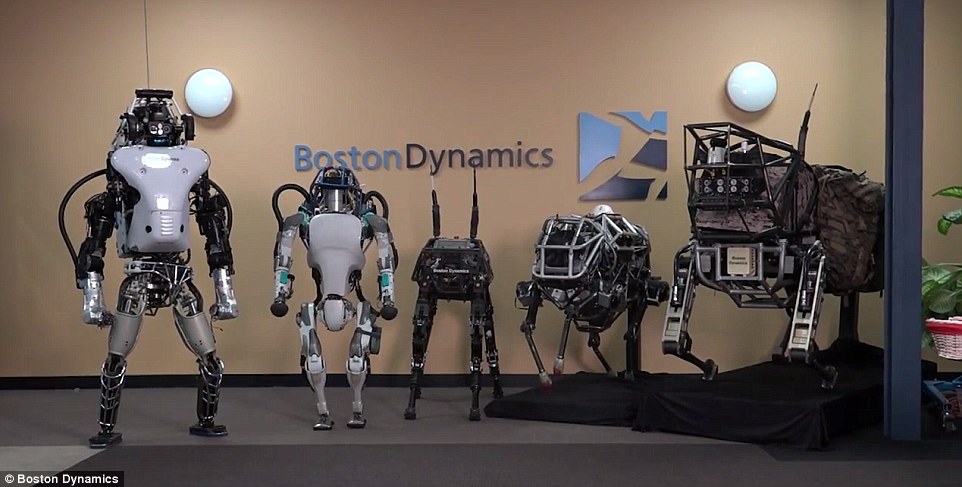Google's Boston Dynamics has revealed the latest version of its humanoid robot - and it can now get up easily on its own if it falls.
The Atlas robot was widely derided at the recent 'robolympics' after falling repeatedly and needing a crane to get up.
However, the new wireless version is shown being pushed over by an employee - and simply getting back up.
Boston Dynamics said the video showed 'a new version of Atlas, designed to operate outdoors and inside buildings.
'It is electrically powered and hydraulically actuated,' the secretive firm said.
'It uses sensors in its body and legs to balance and LIDAR and stereo sensors in its head to avoid obstacles, assess the terrain and help with navigation.
'This version of Atlas is about 5' 9" tall (about a head shorter than the DRC Atlas) and weighs 180 lbs.'
However, the firm released now more details - and the video has no narration.
The video shows the robot walking out of the firm's office and across a snowy plateau.
While lsing its footing several times, it corrects itself and stays upright.
It is also shown moving 10kg boxes with ease in a tight space.
It then faces a more difficult foe - an employee with a hockey stick.
Twenty five of the top robotics organizations in the world were competing for $3.5 million in prizes, and took on a gruelling simulated disaster-response course during the two day contest.
DARPA says 'the DRC is a competition of robot systems and software teams vying to develop robots capable of assisting humans in responding to natural and man-made disasters.
'It was designed to be extremely difficult.
'We get most of our ideas about robotics from science fiction. And we want to show a little bit of science fact,' said Gill Pratt, who organized the competition for the U.S. Defense Advanced Research Projects Agency, which focuses on futuristic
technologies for national security.
The contest runs Friday and Saturday at a Pomona racetrack designed to look like a disaster zone.
The robots may be slow, clumsy and delicate but they might just save lives someday by braving dangerous disaster zones.
Pratt cited the 2011 Fukushima nuclear disaster in Japan as an emergency where such robots would have come in handy.
'Sometimes in a disaster, it is too dangerous for people to go in,' he said.
Teams of engineers, programmers and designers from research institutions across the world have worked for years to build robots that can maneuver the course and complete the assigned tasks.
'We have a valve that we need to turn to shut off a gas leak or something similar,' said John Seminatore, a Virginia Tech graduate student with Team Valor.
'We have to cut a hole in a wall to get access to something behind it. And there will be either rough terrain or rubble that we get past.'
The most difficult task - getting out of the small utility vehicle - is so hard that many teams aren't even attempting the dangerous egress, preferring to be docked on their times rather than risk toppling their robot into the dust.
'Robots don't have that sense of touch that humans do to know where they are inside the car,' Seminatore said. 'So it's going to be really nerve-racking for teams because the training wheels have come off.'
(www.dailymail.co.uk/sciencetech/article-3461251/He-s-Watch-Google-s-new-Atlas-robot-stand-getting-knocked-giant-stick-amazing-video.html#ixzz419xFnAhT)




www.ann.az
Follow us !











